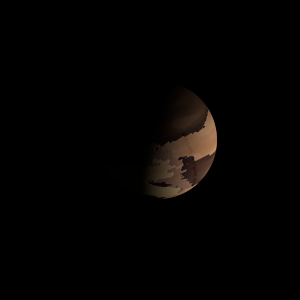|
|
Space Astro
|
Info for exoplanet "Cresbe"
| Scientific (actual) data |
|---|
| Name | Kepler-166 d |
| Planet status | Confirmed |
| Radius | 0.154 |
| Orbital period | 1.554 |
| Discovered | 2016 |
| Updated | 2021-02-05 |
| Tconj | 2455000 |
| Publication | Announced on a website |
| Detection type | Primary Transit |
| Alternate names | 2MASS J19323844+4852522 d, K00481.02, KIC 11192998 d, KOI-481 d, KOI-481.02, WISE J193238.42+485252.3 d |
| Star name | Kepler-166 |
| Right ascension | 293.16° |
| Declination | 48.88° |
| Mag j | 13.346 |
| Mag h | 12.941 |
| Mag k | 12.876 |
| Star distance | 614.16 |
| Star metallicity | -0.286 |
| Star radius | 0.74 |
| Star temperature | 5413 |
| Star alternate names | 2MASS J19323844+4852522, KIC 11192998, KOI-481, WISE J193238.42+485252.3 |
| Wikipedia article | Kepler-166 d |
Back
| |
| Fictional info (?) |
|---|
| Suggested name | Cresbe |
| Planet type | Cold planet |
|
| Atmosphere | Oxygen | 69% |
| Krypton | 30% |
| Ammonium hydrosulfide (NH4SH) | 5.9E-5% |
| Atmospheric pressure | 0.5 bar |
 |
| No known satellites |
| Google search for Cresbe |
|
Website by Joachim Michaelis
|
|
|
|